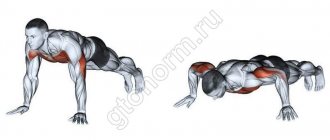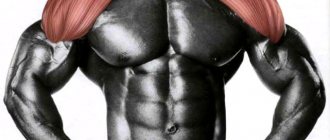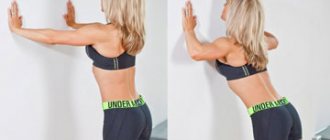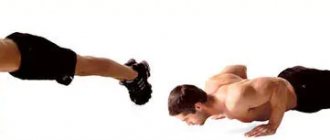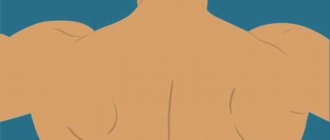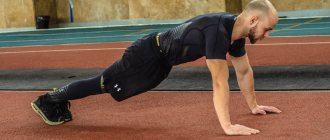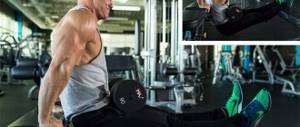Classic
Push-ups with hands resting on the bench are suitable for beginners who cannot do push-ups from the floor. Can be performed with a wide, medium or narrow grip.
When doing push-ups from a bench with a wide grip, the pectoral muscle is mainly involved. Additionally, the anterior delta and triceps work.
You can do push-ups from any elevation. The higher it is, the easier it is to perform the exercise. The height is selected so that you can do eight repetitions.
When doing push-ups, you cannot lift your pelvis up or down; your back and legs should form a single straight line, otherwise the exercise will be less effective.
When lowering, it is recommended to only lightly touch the bench with your chest, and not lean on it with your whole body.
In order not to injure the ligaments, when lowering, the elbows should not be completely retracted to the sides, correctly - to the sides and back.
If you can easily do 15 push-ups from the bench, you can move on to push-ups from the floor.
A difficult option for experienced athletes is to rest your hands on the floor and your feet on the bench.
A parting word about the benefits for the body
Even a person far from sports knows that proper physical activity has benefits for the body. Fit figures attract the attention of the opposite sex, sports reduce the likelihood of hypertension and heart attack, and delay the onset of many diseases. In general terms, floor presses benefit the entire body, especially the cardiovascular system.
Are you planning to take up martial arts? Floor presses should definitely be included in your individual training regimen. It is push-ups that strengthen the hands, especially if the exercise is performed with fists. With systematic practice of all types of push-ups, the muscles of the chest, back and abs, deltoid muscles of the shoulders, calf and intercostal muscles develop. There is also a positive effect on the spine, which is in dire need of a strong muscle corset.
Systematic push-ups develop an entire muscle group
Floor presses can have the opposite effect if performed incorrectly. For example, you definitely shouldn’t start training with additional weight loads right away. First, you need to learn how to perform the basic floor press, which your school physical education teacher so persistently suggested mastering.
Reverse push-ups with feet on the floor
To perform the exercise, you need one bench, on which you need to lean your hands from behind, placing them approximately shoulder-width apart, with your elbows directed back and pressed to the body. Stretch your legs straight forward, rest your heels on the floor. The arms are straightened, the pelvis is raised and is at the level of the bench. This is the starting position.
Slowly bend your elbows and lower yourself down until you feel a strong tension in your triceps. At the bottom point of the movement, hold your breath slightly, take the starting position, fully extending your elbows and keeping them in one position. Stay a little at the top point, tensing your triceps as much as possible, and continue doing the exercise.
What muscles work when doing back bench push-ups? The main one is the triceps, the additional ones are the pectoralis major and the anterior deltoid.
When performing a reverse push-up, you should not spread your arms too wide, otherwise the load will be placed on the pectoral muscles and latissimus dorsi and the effectiveness will decrease. In this exercise, the main muscles worked are the triceps.
Push-ups with your feet above your head
Home Favorites Random article Educational New additions Feedback FAQ⇐ PreviousPage 11 of 36Next ⇒
These push-ups are sometimes mistakenly called incline push-ups. They simply involve doing regular push-ups with your legs raised on any surface higher than your arms. In prison, a lot of guys use their bunk for this, but you can go higher by using a table or a sink. Some men even wedge their legs onto the wall, but this requires a ton of muscle tension to maintain this position. Raising your feet makes the exercise harder by transferring more of your body weight to your arms. Because of the increased angle, this movement targets the shoulders and upper chest more intensely than a regular push-up. I don't advise my students to waste time doing push-ups with their feet above their heads, because handstand push-ups (see Chapter 10) combine all the benefits of this type of push-up in a more concentrated form. If you do handstand push-ups, you simply get the same thing (but less effectively) as if you do push-ups with your feet above your head. You also run the risk of overtraining.
Wide push-ups
These are the opposite of tight push-ups—instead of squeezing your hands together, you place them wider than usual, up to double shoulder width. This variation takes most of the tension away from the triceps and elbow joints and places more pressure on the pectoral muscles at the point where they meet the front of the shoulders. Simply put, they work the chest more than the triceps. This variation of push-ups will not make you much stronger from doing push-ups, because the shoulder-pectoral girdle is usually already proportionately much stronger than the elbow joint; doing this exercise consistently will only increase this difference. However, this is a useful exercise to master if you specialize in your pecs.
Superman push-ups
Full push-ups are usually performed with your hands shoulder-width apart at chest level. In Superman push-ups, you perform your reps with your hands on the floor far in front of you, almost arm's length. In this pose you look as if you are flying - hence the name. Because of the increased arm leverage in this technique, Superman Pushups work the pecs hard, as well as the deltoids and the tendons around the armpits. On the other hand, this position of the arms reduces the range of motion in this exercise and the important shoulders and triceps receive significantly less work than in classic full push-ups. For this reason, this exercise (and wide push-ups) will not make you stronger from doing them, so unless you are trying to correct a relative weakness in the chest area, I would avoid them.
Gecko push-ups
There are four levels of difficulty in gecko push-ups. In the easiest variety, the athlete performs full push-ups, but with one foot behind the other, so that only one foot is in contact with the floor. These are sometimes called three-point push-ups. In the second variation, the athlete lifts one leg up off the floor, but keeps it straight while performing push-ups. This nuance doubles the isometric connection of movement stabilizers: legs, hips, waist and spinal muscles. It also requires more balance and composure than regular push-ups. In the third variation, the athlete leaves both feet on the floor, but extends one arm in front of him at head level.
These are essentially one-arm push-ups, but with one limb pointing forward instead of tucked into the lower back. In the fourth and hardest variety of gecko push-ups, the athlete combines the second and third versions. He raises one arm forward while simultaneously extending the opposite leg back as he performs the movement. Performing push-ups this way requires significant core strength and lower back steel to maintain balance. In this position, the athlete resembles a lizard lifting opposite legs from the hot desert surface, hence the name “gecko” push-up. Gecko push-ups are a fun finishing exercise to add to your routine as you gain strength. Make sure you perform the same number of repetitions on each side to ensure symmetrical development.
Plyometric push-ups
Also known as clap push-ups. These are standard push-ups, but performed at an explosive pace. Keeping your body ramrod stiff, lower yourself quickly to the bottom position before rising up so quickly that your hands briefly lift off the floor. While you are in the air, clap your hands in a split second until your palms touch the floor again and then repeat the exercise. The more powerful you push-up, and the higher you can get off the floor, the more times you can clap before you land. A lot of guys can clap three or even four times. The highest difficulty is in the version of one-arm push-ups with clapping, when you do push-ups on one hand before clapping. Clapping push-ups bring speed and are a great addition to your routine from time to time. However, they can cause injury, so at least work with them until you have mastered uneven push-ups.
Stretch push-ups
These are regular push-ups, but performed with your hands on two elevated objects on either side of your torso. You can buy specially made handles for these push-ups, but placing your hands on two chairs will give you the same effect. When you do push-ups on a flat surface (such as the floor), your range of motion is limited to that surface, but doing push-ups with your hands on elevated objects means that you can lower your chest beyond the point where you would normally stop at the floor.
The feet can be either lower than the hands or at the level (or higher) when resting on a bed, table, other chairs, and so on. I don't really believe in stretch push-ups. Stretching muscles with resistance is painful and leads to increased pain after exercise, but this is entirely due to microtrauma in the muscle tissue, this does not mean that the muscles become bigger and stronger. Stretching your muscles does not increase your size or strength. If you want to create a burning sensation in your pectoral muscles, do stretch push-ups. If you want everything - core muscles and power, work ten stages and skip the stretch push-ups
Jackknife push-ups
With your feet fully planted, place your palms on the ground in front of you so that you are bent at the hips approximately 90 degrees. (This angle is called the pocketknife position because the body resembles an opening pocketknife). Your arms should be approximately shoulder-width apart and, regardless of the angle of your hips, your torso should be straight. Maintain a slight bend in your knees. Bend your arms and shoulders and lower your chin until you kiss the floor between your hands.
Now continue to move your chin in an upward arc as your hips press into the ground. You should complete the movement with your arms and legs straight, your shoulders up and your hips down. Keeping your arms straight, push your butt out and back until you are back in the starting position, then repeat. This exercise is easier on the core than regular push-ups, although the jackknife curl and straightening motion will build strong, flexible hips. For this reason, this exercise is popular among martial artists and wrestlers. In some cases, this exercise is known as cat push-ups, or by their Indian name - ???
Diver push-ups
These were popular in the naval branches of the military, back in the 70s. They are similar to jackknife push-ups, except that you bend your arms as you return to the starting position (with jackknife push-ups, you bend your arms as you lower your hips, but keep your arms straight as they come back down). The arm curl doubles the upper arm engagement, but reduces the exercise's effectiveness as a stretching movement.
Diagonal push-ups
Take the same bent position as at the beginning of jackknife push-ups. Your body should be bent well at the waist, with your hips set high, and your arms and legs almost straight. Keeping your legs closed will make everything much more difficult. Now bend your arms, but instead of lowering your hips like a knife or diver pushup, keep your body locked into a 90-degree angle. Continue bending your arms until your forehead lightly touches the floor and push back. Your body should maintain the same angle until you complete all your repetitions. This is easier to do if you press your heels against the wall. This exercise works your shoulders more than regular push-ups. They're fun to do, but as with push-ups, handstand push-ups are a much better alternative if you want to work your shoulders hard.
Plank
The plank is not actually a push-up. It is a static display of strength that was popular among athletes of the second Golden Era, although its roots go back much further. The ancients loved this exercise, and for good reason—the plank requires strength from almost every muscle in the body, as well as balance and coordination. In addition, it allows you to show off coolly. Place your palms on the floor shoulder-width apart, bend your arms, rest your elbows on your torso and lean forward until your feet leave the ground with your legs tense. To maintain this pose, your back and legs must be as stiff as a board—hence the name plank.
This is an extremely difficult exercise to imagine without a picture, so I've included a photo below to help. This exercise is very difficult to pull off, the key to it is persistence in the process of building the foundations of strength through training in the ten step system. Keep pushing and I guarantee you will achieve it. The plank was popular among Canadian athletes and for this reason it is often known by its French name - plank. In English-speaking countries it is sometimes known by its gymnastic name, elbow stand.
Incline tiger curls
This exercise is done by a ton of bodybuilders who find themselves in jail and want to maintain their arm size. Although this is a bodyweight exercise, it's more like a dumbbell triceps workout than a real push-up because it works the triceps and doesn't target the chest or shoulders. Lean forward at a 45-degree angle, grabbing a solid object in front of you. In prison, a vanity sink usually suffices, but if you're working out at home, a kitchen cabinet or countertop might do the trick. You can even do this exercise with your palms on the floor in front of your chest. Keeping your elbows pointed down, bend your arms only at the elbows, without touching your shoulders. Continue moving forward as far as you can or until your upper arms touch your torso, then push up. Lots of correct reps will leave your triceps begging for mercy.
Maltese push-ups
This little-known push-up variation is often used by gymnasts because it partially mimics ring training. Maltese push-ups are a bit like full push-ups, but the hands are placed in line with the hips and far enough away from the body. If you draw one line along the athlete's torso and another from one palm to the other in this pose, these lines form something like a Maltese cross, hence the name of this exercise. The movements required by this type of push-up are difficult to assess unless you actually see an expert perform it. Maltese push-ups work the biceps as well as the triceps, but this technique can be tough on the insides of the elbows. If you're not a gymnast, I'd ignore them.
Squats:
⇐ Previous11Next ⇒
Reverse push-ups with feet on a bench
The benches need to be placed parallel to each other. The distance between them is about 90 cm. Sit on one of them, holding its edge with your fingers, palms resting on the bench and located approximately shoulder-width apart, maybe a little wider, elbows back. Place your feet on another bench. Fully straighten your arms at the elbows, lift your pelvis off the bench and move it forward so that it extends beyond the bench.
Slowly bending your elbows, lower yourself between the benches until maximum tension appears in your triceps. At the lowest point, hold your breath, then straighten your arms completely, tighten your triceps muscles even more and do the next repetition.
During the exercise, do not spread your elbows; they should always look back. You need to make sure that your back is as close to the edge of the bench as possible, and that your torso moves up and down.
Triceps push-ups can be made more challenging by placing a weight on your hips, such as a barbell disc.
The pectoral muscles and anterior deltoids are stressed at the very beginning of the lift; the higher the lift, the more the triceps are involved. If you spread your elbows to the sides, the load on the target muscles will noticeably decrease. If you place your hands a little wider than your shoulders, there will be less temptation to spread your elbows out to the sides. During the set, you need to keep your head straight, do not tilt it down and look only forward.
If the exercise is performed in full amplitude, it is not necessary to take weights; your own body weight will be enough as a load.
It is recommended to use the barbell disc only for experienced athletes. Beginners should learn the technique without weights, they need to do push-ups in partial amplitude and increase it as they increase the strength of the triceps muscles of the shoulder.
Push-ups: how to do them correctly
Push-ups are the most popular bodyweight exercise. It is used not only in strength training, but also in plyometric exercises, CrossFit, Pilates, callanetics and even yoga. And this versatility of push-ups is easily explained. Push-ups help you engage every muscle group from your neck to your toes, and especially strengthen your pectoral muscles, shoulder girdle, triceps, and abs.
There are many different types of push-ups, but before moving on to more complex modifications of this exercise, let's understand the technique of performing classic push-ups. The correct form of exercise is not only maximum results and high-quality muscle work, but also reduces the risk of injuries and damage during exercise.
Correct technique during classic push-ups:
- The body forms a straight line, the pelvis does not go up and does not bend down.
- The abdominal muscles are tense, but breathing is not held.
- The head is in a neutral position, not looking down, but not lifting up either.
- The palms are strictly under the shoulders and do not go forward.
- Palms face forward, parallel to each other.
- The elbows are turned back 45 degrees, they are not spread out to the side.
- As you inhale, bend your elbows and lower your body parallel to the floor, maintaining a straight body line.
- Push-ups are performed with full amplitude, i.e. the body drops as low as possible. Elbows should form a right angle.
It is this technique of classic push-ups that helps to evenly work the muscles of the shoulders, chest and triceps.
Push-ups work several muscle groups at once. This exercise allows you to work all the muscles of the shoulder girdle and the small stabilizing muscles of the shoulder. Also, push-ups from the floor and from the knees develop strength and elasticity of the shoulder muscles, which is especially important since the shoulder joint is extremely unstable and susceptible to displacement and injury.
Push-ups help work the following muscle groups:
- Pectoralis major muscle
- Deltoids (shoulders)
- Triceps
- Serratus anterior muscle
- Abdominal muscles
In addition, during push-ups, the muscles of the legs, buttocks and back are indirectly involved in the work. Push-ups also increase the functional strength necessary to perform regularly performed actions (lifting and moving objects, cleaning the house, holding a child in your arms).
Read more about functional training
Triceps workout
A little physiology. Triceps (triceps muscle) is the back muscle of the humerus, thanks to which the elbow flexes and extends. When doing push-ups, it always works, however... This muscle is small in size, so the load on it is distributed among other muscle groups. To maximize the involvement of the triceps muscle, it is necessary:
- Minimize the work of the pectoral muscles. Reduction of the shoulder blades is excluded.
- Use correct hand placement. It is better to place your palms shoulder-width apart. In this case, the elbows will be pulled back and located along the body.
- Practice reverse push-ups. You will need a gymnastic bench or any other similar support, with your arms behind your back.
When working on the triceps, it is important to remember that this muscle will work during the floor press only in the absence of contraction of the shoulder blades. In this case, the body will rise not with the help of the pectoral muscles, but solely due to the extension and flexion of the elbows.
When training triceps, it is important to avoid retraction of the shoulder blades.
Ballistic exercises and crossfit
Push-ups help strengthen your hands and prepare them for striking a punching bag or sparring partner. It is possible to begin the steepest and, at the same time, the most traumatic types of push-ups, in which the backs of the hands, fists and fingers are used as support, only after a detailed study of all the above muscle groups.
Explosive Strength Development
Plyometric (also called “ballistic” or “explosive”) exercises allow you to ensure maximum muscle work in a minimum amount of time. A must have for athletes who consider themselves to be “advanced”. They include two basic types of push-ups:
- Floor presses with hand clapping. The good old “Spartan” floor press. Both hands are shoulder-width apart, one hand is slightly in front of the other. When doing push-ups after clapping, the position of the hands changes.
- Burpee (burpee) refers to the abolition of the CrossFit system, the algorithm of which looks like this: squat, palms on the floor in front of you; with a push, the legs are straightened, the body is parallel to the floor in a press position; push-ups; return to squat; jumping with arms stretched upward; return to the starting position.
All push-ups aimed at developing explosive strength are performed at high speed, without pauses and with maximum muscle work in their positive and negative phases.
Clapping push-ups are important to perform at high speed.
Stimulating muscle growth
To stimulate muscle growth, you need to use additional load in the form of weight when doing presses. It could be a barbell, a heavy backpack, a weighted vest, or a girl. In this case, it is recommended to perform push-ups with both wide and narrow arms positioned alternately.

